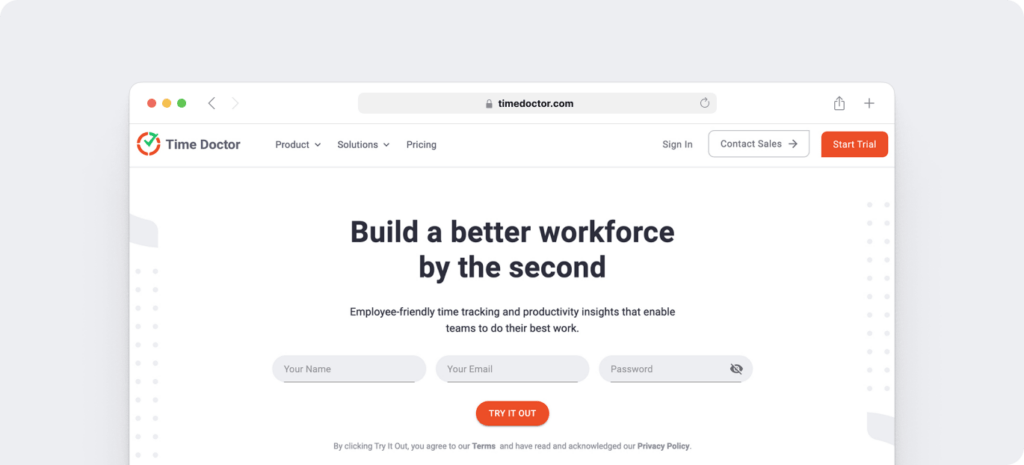Wondering how to avoid time wasters?
Everyone wants to be at their productive best and have absolute control over their time.
Unfortunately, from the latest Netflix show to unnecessary watercooler talks, there are so many things that can take away your focus from important matters.
But once you identify such time wasters, it’s fairly easy to avoid them and manage your time well.
Don’t worry; you don’t have to be a productivity expert for this.
In this article, we’ll highlight six common workplace time wasters and tell you some simple ways to avoid them easily. We’ll also cover how a productivity management tool can help keep track of your time usage.
This article contains:
- Social Media Distraction
- Constantly Checking Your Emails
- Lack of Prioritization
- Procrastination
- Unproductive Meetings
- Watercooler Conversations
How A Productivity Management Tool Helps You Avoid Time Wasters
Let’s dive right in.
6 huge workplace time wasters
Knowing how employees waste time in the workplace is essential — especially for a small business owner whose business growth depends on how productive your team is.
By identifying time wasters, you can take the right steps to avoid them and use the saved time to focus on important tasks or projects.
Let’s take a close look at six common workplace time wasters and how to avoid them:
1. Social media distraction

Do you remember how many times you felt like having a quick peek at your Twitter or Facebook page only to end up wasting an hour?
Social media activity isn’t limited to just following each other.
You also spend hours uploading new posts, commenting, having conversations, or simply scrolling your feed.
And unless your work involves social media management, you don’t have to waste endless hours on social accounts — especially during work timings.
When your attention gets diverted while working on an important task, it’ll be harder for you to regain that train of thought, which leads to more time wastage.
How to steer clear of social media distraction?
The best way to overcome social media distraction is to set a specific time during the day when you can log in to your accounts. It could be when you’re taking a short break or after work hours.
Additionally, you can use productivity management software to limit your usage on specific social media sites or even block access to the whole website, like Facebook, during work hours. This acts as a huge time saver as it prevents social media from interfering with your work.
2. Constantly checking your emails

You may not realize it, but checking your inbox is a huge waste of time.
A study published in Harvard Business Review estimated that an average person spends about 28% of the workday reading and answering emails. That’s equivalent to losing about 2.6 hours of precious work time — just to emails!
Sure, some emails are important (especially if you’re a salesperson), but the fact is the majority of them aren’t. And chances are, there are far more essential things you could be doing than wasting time checking your inbox.
However, that isn’t all.
While going through your inbox wastes time, it can also lead you to waste more time on other tasks.
Confused?
When you check your inbox, you’re diverting attention away from whatever else you were doing. And when you eventually get back to that task later, it’s going to take you an extra hour to get back in the right frame of mind to be at your productive best.
How to avoid wasting time checking emails?
Learn how to prioritize (more on task prioritization in a minute).
The subject line of the mail already tells you if it is essential or not. Dedicate a certain amount of time every day to address your emails and cap it at no longer than 30 minutes. By giving yourself this time-limit you’re forcing yourself to only focus on really important things.
Additionally, a lot of these emails come to you because you’ve subscribed to various sites. Try and unsubscribe from anything not immediately valuable to reduce inbox clutter.
3. Lack of prioritization

Your to-do list can have several tasks that need your attention.
However, if you don’t prioritize the right tasks, you could waste precious minutes doing tasks that aren’t really important — even if you know what you need to accomplish.
Most of us waste time due to poor prioritization, doing tasks that make us feel busy without actually helping us make any headway. This makes it a huge waster of time, especially for multitasking individuals.
Moreover, you could get confused about what’s actually urgent without clear priorities — especially if you have multiple large tasks or projects.
How to prioritize work?
There are several ways to prioritize work.
You can use the Eisenhower Matrix, a prioritization method where tasks are categorized into different quadrants based on their importance and urgency. You can also make a list of the three most important tasks you need to do for a day and use the rest of the time to complete the less important tasks.
Additionally, make it a habit to sit down and plan ahead — be it for the next day or an entire week.
Open your notepad or a piece of paper and jot down what tasks you’ll have to do. You can even break them down to make it much easier. This way, you can hit the ground running first thing in the morning.
4. Procrastination

We all have some tasks that we either find too difficult to tackle or simply just don’t want to do.
An average person keeps postponing it until it becomes undeniably urgent — a common issue tied to the lack of prioritization. However, procrastinating any task never really helps.
Why?
Just because you pushed the task to another time or day doesn’t really make the task disappear. It’s still there, waiting for you to complete it.
Moreover, if you procrastinate for an extended period, you can become demotivated, leading to reduced productivity.
How to avoid procrastination?
Learn to bite the bullet. Instead of postponing the task, just get it done right then.
However, this ultimately depends on how important and urgent the task is. The Eisenhower Matrix and other methods we discussed above can be useful here.
Here are some other tips to help you stop procrastinating work:
- Set a simple, achievable goal and commit to it.
- Create a schedule and set specific times for completing each task.
- Take breaks in between tasks to relax and refresh your mind.
- Try completing the most difficult tasks during your most productive hour.
- Breakdown large tasks into smaller subtasks or checklists.
- Minimize any non-work distraction to help you focus on the task at hand.
5. Unproductive meetings

Let’s face it: not all work meetings are necessary.
Holding a meeting just to explain tasks or share project updates are simply huge time wasters.
Not only are you wasting your own time, but you also take the focus of other attendees — giving them less time to complete their tasks.
A recent survey reported that around 31 hours are spent on unnecessary meetings per month, with each meeting time being about 30 minutes to an hour.
Besides, to schedule meetings itself takes a lot of time. You need to invite attendees, send out timely reminders, or even deal with technical issues along the way.
Additionally, if there’s no clear takeaway from the meeting, attendees might feel uninterested — which could lower their productivity post-meeting.
As a rule of thumb, meetings with no/unclear goal, time frame, or takeaway are just massive time wasters.
How to avoid unnecessary meetings?
Using a project management tool is an excellent way to eliminate status meetings. Co-workers only have to check the software to see where everyone is placed.
If you’re confused about whether to hold a meeting or not, just ask yourself:
“Can I convey this information over a text message, email, or phone call?
If the answer is yes, then there’s no need for scheduling a meeting to convey that information.
Another tip to hold productive meetings is to set a clear agenda and time limit.
Whether it’s a virtual team bonding session or a project planning meeting, decide what needs to be discussed well in advance. Then, set a time limit and send out relevant materials 30 minutes before the meeting.
This way, all attendees will be on the same page regarding what’s being discussed and how long the meeting will be — helping them plan the rest of their day accordingly.
6. Watercooler conversations

One of the biggest time waster in workplaces, “watercooler conversations” is anything non-work related discussed during work hours. These discussions can go on for a long time, which dramatically reduces valuable time.
Sure, such casual discussions and free time are necessary for improved team bonding and work relationships.
However, as an employer, you don’t want it to reduce the amount of work done every day.
Watercooler discussions might also provide a space for miscommunications among team members — especially if a particular task or project information wasn’t clearly conveyed to them.
How to reduce watercooler conversations?
Reducing this waster is a surefire way to save time in the workplace.
To do it, an employer can create policies around casual discussions and breaks.
Clarify when and how long workers can take breaks for. While this helps limit their idle time, ensure that you give sufficient time for productivity reasons.
Additionally, use productivity management software to help you keep track of each employee’s time usage. You’ll quickly know if anyone’s taking too many breaks and for how long they were away from their desk.
How a productivity management tool helps you avoid time wasters
Identifying time wasters in your workplace is an excellent way to improve productivity and time management.
And while you can always create relevant policies or awareness among your workers, keeping track of how each person spends their work time can be challenging.
Luckily, with a productivity management tool, that’s incredibly easy!
Employee performance tracker software automatically keeps tabs on each employee’s time usage when they clock in for work (until they clock out).
It gives you access to critical information like:
- If your team is actively working on their tasks and projects.
- What tasks they worked on and for how long.
- What websites and apps they accessed during work hours.
- If anyone has poor time management.
And when it comes to employee productivity management, there’s no tool as comprehensive as Time Doctor.
What’s Time Doctor?

Time Doctor is a powerful time tracking and employee productivity management tool used by large companies and SMBs to monitor employee performance.
With several employee-friendly settings, Time Doctor gives absolute clarity over where time is being spent — for any employee and manager.
Here’s a quick look at some of Time Doctor’s robust features:
- Manual and automatic time tracking modes to track task time any way you want.
- Accurate productivity reports give detailed insights into the performance of each person.
- Categorize any website and app, like YouTube and Twitter, as productive/unproductive based on your needs.
- Offline and online time tracking functionality for maximum flexibility.
- Track each user’s idle time to make sure everyone’s working actively on their projects.
- See which website and app a person used during any working day.
- Use the Chrome extension to track time usage across other workplace software like Google Apps, Trello, Jira, Salesforce, and more.
- Track time usage on the move using your Android smartphone.
Wrapping up
Time wasters are common workplace issues that must be dealt with to boost productivity and grow your business.
Use the tips we covered here to deal with the six common time wasters efficiently. And even if you might face other time management issues, these tips are sure to come in handy to resolve them.
However, remember, with a productivity management system in place, dealing with wasted time and other productivity issues become all the more easier.

Liam Martin is a co-founder of Time Doctor which is software to improve productivity and help keep track and know what your team is working on, even when working from home.


